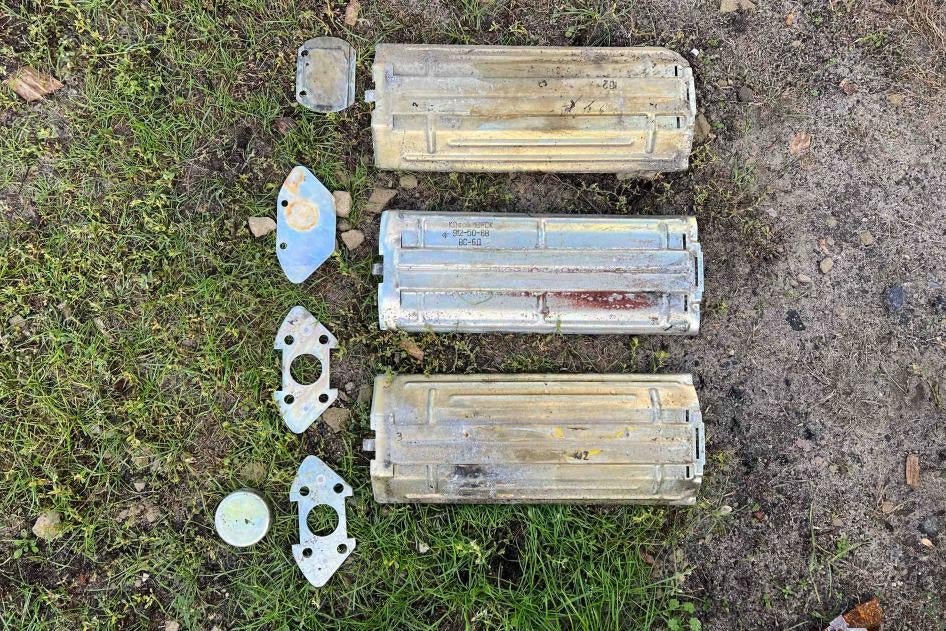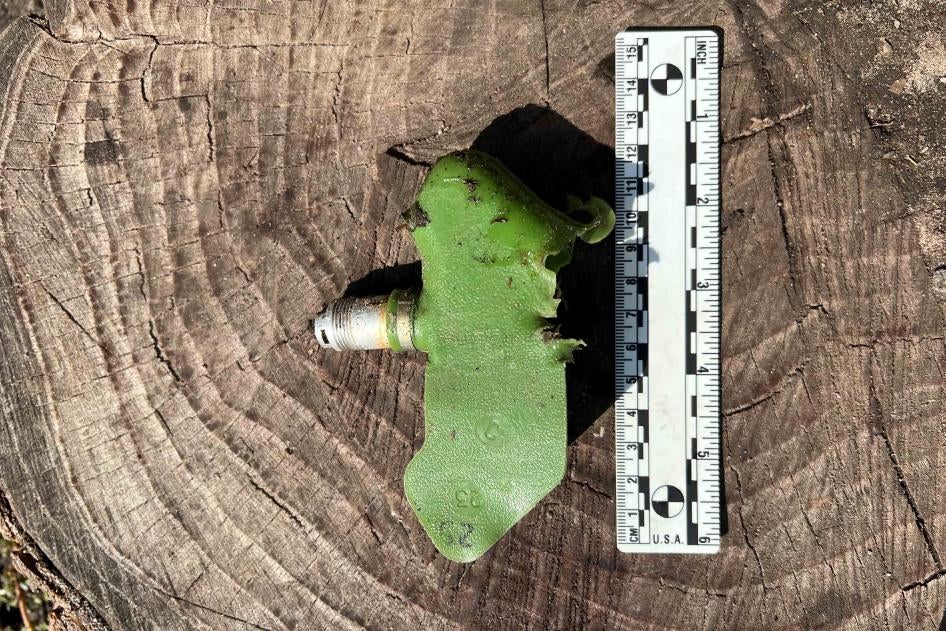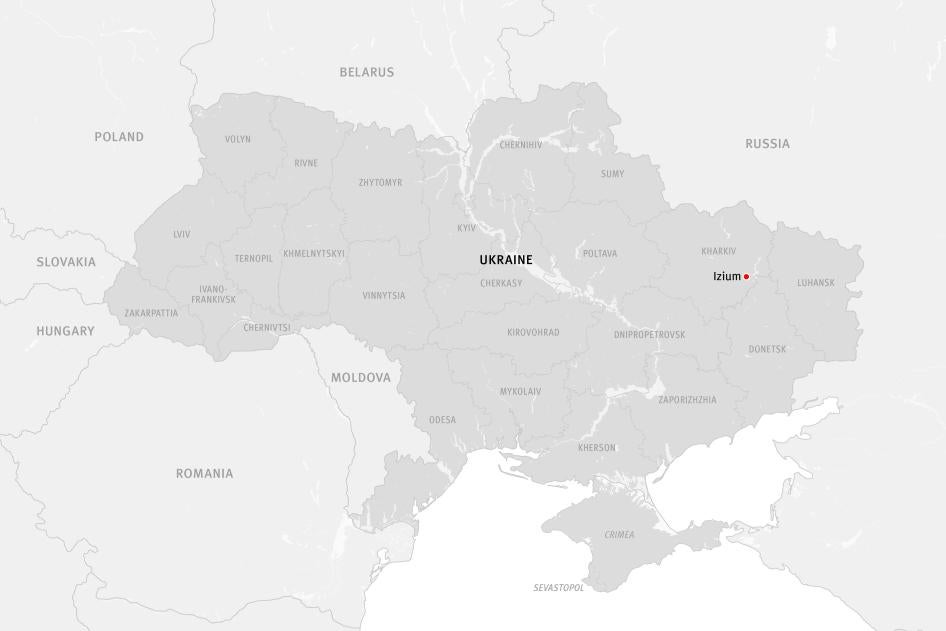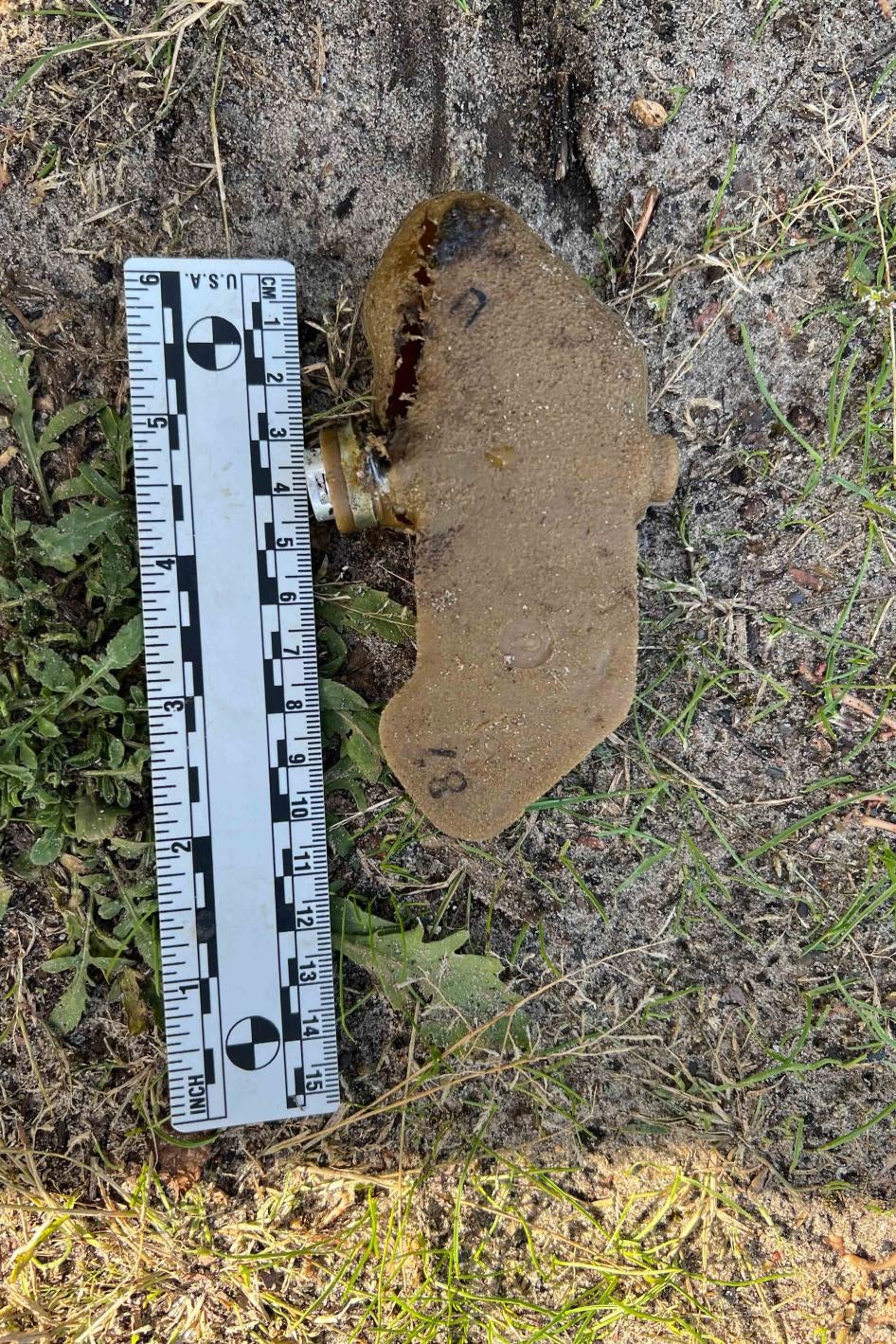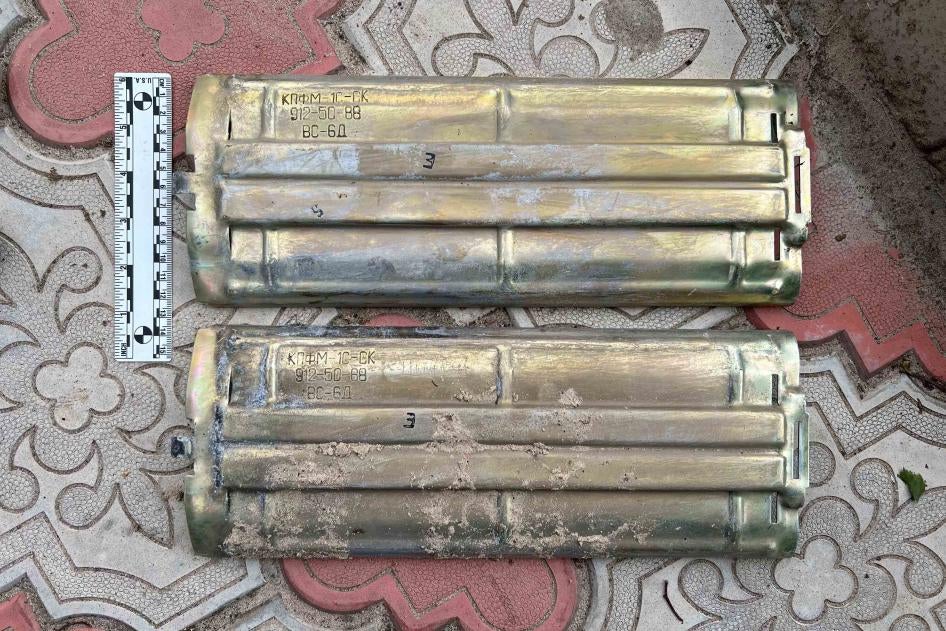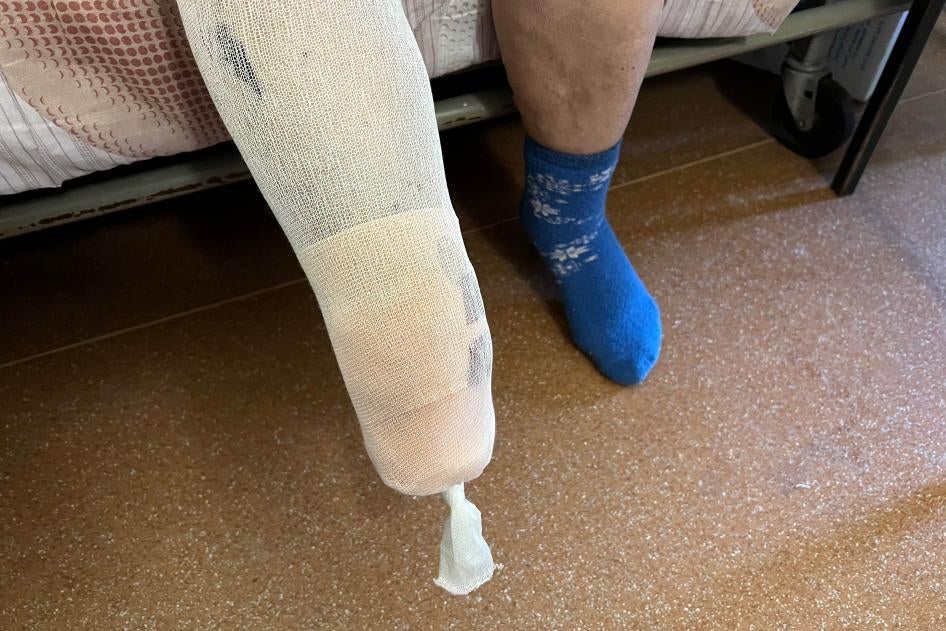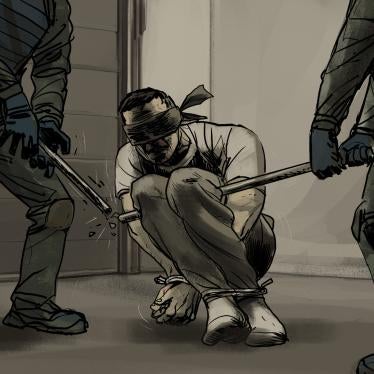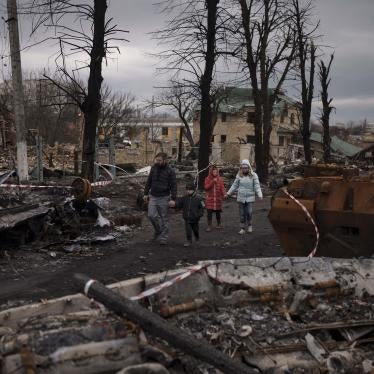Update: Human Rights Watch welcomes Ukraine’s commitment to duly study the below report on antipersonnel landmines, as announced in a statement by the Ministry of Foreign Affairs on January 31. We hope that the government will carry out a prompt, thorough, and impartial investigation into our findings. We welcome further dialogue with the Ukrainian authorities on this issue.
(Kyiv, January 31, 2023) – Ukraine should investigate its military’s apparent use of thousands of rocket-fired antipersonnel landmines in and around the eastern city of Izium when Russian forces occupied the area, Human Rights Watch said today.
Human Rights Watch documented numerous cases in which rockets carrying PFM antipersonnel mines, also called “butterfly mines” or “petal mines,” were fired into Russian-occupied areas near Russian military facilities. Ukraine is a state party to the 1997 Mine Ban Treaty, which prohibits any use of antipersonnel mines.
Russian forces have used antipersonnel mines in multiple areas across Ukraine, including victim-activated booby traps, since its full-scale invasion of Ukraine on February 24, 2022. Human Rights Watch previously published three reports documenting Russian forces’ use of antipersonnel landmines in Ukraine in 2022.
“Ukrainian forces appear to have extensively scattered landmines around the Izium area, causing civilian casualties and posing an ongoing risk,” said Steve Goose, Arms Division director at Human Rights Watch. “Russian forces have repeatedly used antipersonnel mines and committed atrocities across the country, but this doesn’t justify Ukrainian use of these prohibited weapons.”
While most types of antipersonnel mines are emplaced by hand, the PFM antipersonnel mines used in and around Izium operate only when scattered by aircraft, rockets, and artillery, or when fired from specialized vehicles or launchers. The use of antipersonnel mines violates international humanitarian law because they cannot discriminate between civilians and combatants. Uncleared landmines drive displacement, hinder the delivery of humanitarian aid, and prevent agricultural activities.
The Russian military seized Izium and the surrounding areas by April 1 and exercised full control there until early September when Ukrainian forces began a counteroffensive. During their occupation, Russian forces arbitrarily detained, interrogated and tortured residents, and in some cases forcibly disappeared and killed civilians.
Human Rights Watch conducted research in the Izium district from September 19 to October 9, interviewing over 100 people, including witnesses to landmine use, victims of landmines, first responders, doctors, and Ukrainian deminers. Everyone interviewed said they had seen mines on the ground, knew someone who was injured by one, or had been warned about their presence during Russia’s occupation of Izium.
Human Rights Watch documented PFM mine use in nine different areas in and around Izium city and verified 11 civilian casualties from these mines.
Healthcare workers said that they treated nearly 50 civilians, including at least five children, who were apparently injured from antipersonnel mines in the area during or after the Russian military occupation. About half of the injuries involved traumatic amputations of the foot or lower leg, injuries consistent with PFM blast mines. Researchers were unable to determine if Russian military personnel were injured or killed in rocket attacks that dispersed landmines.
“They are everywhere,” one Ukrainian deminer said, referring to PFM mines in the Izium area. Deminers estimated it could take decades to clear the area of landmines and other unexploded ordnance.
Human Rights Watch saw physical evidence of PFM antipersonnel mine use in seven of the nine areas in and around Izium. This includes unexploded mines, remnants of mines, and the metal cassettes that carry the mines in rockets. In multiple locations, researchers observed blast signatures that were consistent with the amount of explosive contained in PFM antipersonnel mines. In the two other areas, multiple witnesses said they had seen mines that matched the description of PFM mines.
In six of the nine areas, witnesses described attacks consistent with landmines delivered by rocket artillery. In three locations in the Izium area, Human Rights Watch saw how the rocket motor of an Uragan-series artillery rocket, which can be used for mine dispersal, was lodged in the ground or had hit a building in such a way that indicated it had come from the direction where Ukrainian forces controlled territory, and were within the 35-kilometer maximum range of these rockets, at the time of the attack.
The nine areas were all close to where Russian military forces were positioned at the time, suggesting they were the target. Russian forces were retreating from these positions in early September, but witnesses said that the two attacks Human Rights Watch documented on September 9 and 10 occurred when Russian forces were still present in those areas.
More than 100 residents of Izium and the surrounding area said that Russian forces or occupation authorities posted and distributed flyers to warn of the landmine danger. They also cleared landmines from public areas and civilians’ private property and took some mine victims to Russia for medical care – actions inconsistent with being responsible for laying the mines. Human Rights Watch interviewed two landmine victims who said that Russian forces transferred them by military helicopter to Russia for medical care.
Human Rights Watch has documented Russia’s use of other kinds of antipersonnel mines in Ukraine but has not verified claims of Russian forces using PFM mines in the armed conflict.
The 1997 Mine Ban Treaty comprehensively bans antipersonnel mines and requires destruction of stocks, clearance of mined areas, and assistance to victims. Ukraine signed the Mine Ban Treaty on February 24, 1999, and ratified it on December 27, 2005. Russia has not joined the treaty, but it is still in violation of international law when using antipersonnel mines given their inherently indiscriminate nature. The Mine Ban Treaty entered into force on March 1, 1999, and its 164 states include all NATO member states, except the US, and all European Union member states.
Ukraine inherited a substantial stockpile of antipersonnel mines after the breakup of the Soviet Union. It destroyed more than 3.4 million antipersonnel mines between 1999 and 2020, including PFM mines. In 2021, Ukraine reported to the UN secretary-general that 3.3 million stockpiled PFM mines still need to be destroyed. According to Ukrainian officials, the only type of antipersonnel mines remaining in Ukraine’s stockpiles are PFM mines contained in 9M27K3 220mm rockets. Human Rights Watch previously documented the use of antipersonnel mines in Ukraine in 2014 and 2015 by Russian-backed armed groups.
Under Article 20 of the Mine Ban Treaty, a state party engaging in armed conflict is not allowed to withdraw from the treaty before the end of the armed conflict. The treaty is also not subject to reservations.
Human Rights Watch submitted a series of questions about PFM antipersonnel landmine use in and around Izium to the Ukrainian Ministries of Defense and Foreign Affairs and the Office of the President on November 3, and requested a meeting. Human Rights Watch also contacted multiple officials in the government to facilitate a meeting.
On November 23, the Defense Ministry provided a written response, saying that the military abides by its international obligations, including the prohibition of the use of any antipersonnel mines, but without addressing any of the questions about PFM mine use in and around Izium, noting that “information on the types of weapons used by Ukraine ... is not to be commented on before the war ends.”
At the Mine Ban Treaty’s 20th Meeting of States Parties on November 24, 2022, Ukraine said it is a “responsible party” to the treaty and “never considered” using its antipersonnel mine stocks for defensive purposes.
Ukraine should recommit to the Mine Ban Treaty’s strict prohibitions, open an investigation into the recent apparent use of PFM antipersonnel mines, hold those responsible to account, and take steps to secure and destroy its stocks of antipersonnel mines, Human Rights Watch said. Ukraine should also ensure that it tries to identify and assist victims, including by providing appropriate and timely compensation, medical care, and other assistance, such as the provision of prosthetics where appropriate and ongoing rehabilitation support, including psychosocial support.
Russia should stop using antipersonnel landmines due to their indiscriminate nature, investigate their forces' use of them, and join the Mine Ban Treaty, Human Rights Watch said.
Human Rights Watch co-founded and chairs the International Campaign to Ban Landmines (ICBL), a 1997 Nobel Peace Prize co-laureate.
“Any use of antipersonnel landmines is unlawful, and Ukraine should thoroughly investigate what happened and ensure its forces do not use them,” Goose said. “Authorities should also ensure that assistance is provided to any civilian or their family found to have been harmed or killed by these indiscriminate weapons.”
For more information on the landmine incidents documented by Human Rights Watch and the Ukrainian government’s response, please see below.
PFM mines, also called “petal” or “butterfly” mines, are small plastic blast mines that are fired into an area, land on the ground and detonate when pressure is applied to the body of the mine, for example when someone steps on it. The PFM mine can also detonate upon being handled or moved. Some PFM mines can self-destruct, exploding randomly up to 40 hours after being used. Antipersonnel mines explode by the presence, proximity, or contact of a person, and can kill and injure people long after armed conflicts end.
All the witnesses interviewed described the same type of mine. Some described the mine’s colors, physical characteristics, and the way it operated. Many of those interviewed said they had seen mines on the ground and showed researchers the physical remnants. Others identified an image of PFM antipersonnel mines after describing what they had seen.
Areas and Time Periods of PFM Mine Use in Izium District
|
|
Village/City |
Area |
Date of Discovery |
|
1 |
Kapytolivka Village, east of Izium |
Village center |
Late April |
|
2 |
Izium |
Central District/along Heroiv - Chornobyltsiv Street |
Early June |
|
3 |
Izium |
Central District/near Kindergarten No. 12 |
Summer |
|
4 |
Izium |
Central District/Izium Central Hospital |
Mid-July/Late Summer |
|
5 |
Izium |
Central District/Southern Izium |
Mid-July/Early August |
|
6 |
Izium |
Central District/northern part of Right Bank |
July/Mid-August |
|
7 |
Hlyns'ke Village, northwest of Izium |
Western edge of village |
Late August |
|
8 |
Izium |
Neighborhood south of Shekspira Street |
September 9/10 |
|
9 |
Izium |
Neighborhood around School No. 6 |
September 10 |
General areas and time periods when witnesses observed antipersonnel mines in and around Izium. Human Rights Watch corroborated the time period for each incident with multiple individuals. Researchers either observed remnants directly in these areas or witnesses said they saw the PFM-series antipersonnel mines, with the aid of reference materials. In each location, witnesses observed or reported at least several mines.
Uragan-series rockets have a range of 10 to 35 kilometers. Throughout the duration of the Russian occupation of Izium and the surrounding area, Ukrainian forces controlled territory to the northwest, west, southwest, and south, close enough to enable them to target Izium with Uragan-series artillery rockets carrying submunitions and the PFM mines.
Russian forces also controlled territory around Izium for the duration of the occupation from which they would have been able to fire rocket artillery from a minimum of 10 kilometers away and into areas occupied by its forces and Ukrainian civilians. However, a scenario in which Russia, repeatedly over the course of five months, used antipersonnel landmines against its own troops and across territory it hoped to control permanently is highly unlikely.
Izium residents said that they began seeing Ukrainian forces in the central part of Izium city either late on September 10 or on September 11. Human Rights Watch did not document any PFM mine use in the area after that date.
Rocket Delivery of PFM Antipersonnel Mines
PFM antipersonnel mines can be deployed in various ways: by hand-carried ground launchers, vehicle-mounted launchers, fixed-wing aircraft and helicopters, and ground-fired 122mm Grad and 220mm Uragan rockets. Human Rights Watch did not find any remnants of the KSF-1 series cassettes or BKF-PFM cassettes required to deliver these mines using platforms other than rockets, such as a truck or air-delivered methods or the use of hand-carried ground launchers.
The 220mm 9M27K3 Uragan mine-laying rocket opens in flight using a small explosive charge to separate it from the rocket motor section of the weapon and scatters 312 PFM mines into an area. Human Rights Watch researchers found several unique types of cassettes, including KPFM-1S-SK, used for the delivery of PFM mines by 220mm Uragan rockets.
Human Rights Watch spoke to witnesses whose descriptions of PFM mine use in six areas were consistent with that of rocket delivery. Each witness described hearing a rocket or an explosion followed either by the sound of the mines hitting or “slapping” the ground or building roofs or observing them for the first time in the minutes following the in-air-explosions of the rockets, which many residents mistook for a cluster munitions attack, which would disperse dozens of small submunitions that are designed to detonate upon impact. Residents in Izium told Human Rights Watch that rocket attacks happened frequently during the Russian occupation. Human Rights Watch is investigating allegations of the use of rocket-delivered cluster munitions in Izium and the surrounding territory during the Russian occupation of these areas.
Areas and Time Periods When Rocket Attacks Were Observed
|
|
Village/City |
Area |
Date |
|
1 |
Kapytolivka Village, east of Izium |
Village center |
Late April |
|
2 |
Izium |
Central District/ Izium Central Hospital |
Mid-July |
|
3 |
Izium |
Central District/ Southern Izium |
Mid-July |
|
4 |
Izium |
Central District/ northern part of Right Bank |
July |
|
5 |
Izium |
Neighborhood south of Shakespeare Street |
September 9 |
|
6 |
Izium |
Neighborhood around School No. 6 |
September 10 |
In another distinct area where PFM mines were used, Human Rights Watch did not speak to witnesses who had observed the moment of delivery, but physical evidence indicates that mines in this area were also delivered by rocket.
Human Rights Watch researchers found rocket motor sections of Uragan series rockets of the kind that are capable of carrying submunitions, as well as the PFM mines in cassettes, that were stuck in the ground or otherwise struck buildings in such a way to indicate they came from the south and west of the Izium area, where Ukrainian forces had control of the territory. Repeated firing of rocket artillery at the city of Izium from late February to early September, and ongoing demining operations by both Russian and Ukrainian forces, prevented Human Rights Watch from determining which rocket motor or carrier section was associated with each attack.
Civilian Casualties
Human Rights Watch verified 11 cases of civilian casualties from PFM mines in and around Izium. Four lost their foot or lower leg after stepping on a mine. One, a 77-year-old man, died some days after he was injured by a mine, although other factors beyond his mine-inflicted injuries may have played a role.
One healthcare worker at Izium’s central hospital said that between April and September 21, medical staff had amputated 20 to 30 lower limbs as a result of injuries caused by these mines. On October 24, healthcare workers said that the number of civilian casualties from the mines, most resulting in a traumatic amputation, had risen to almost 50, including five children.
“I know they are traumas from butterfly mines because of specific features: no evidence of fragments in wounds that is typical for others,” one healthcare worker said. “Only explosive substance, and it tears off the lower third of the leg. When you are a little far, it will not harm you, but when you step on it, it will harm you.”
Human Rights Watch spoke with two people who, after getting injured by these mines, were transferred on Russian military helicopters from the central hospital in Izium to hospitals in Russia, where they received medical care. Both left Russia after their treatment.
Human Rights Watch documented no use of PFM mines after September 10, when Russian forces withdrew from the area, but civilians continued to fall victim to antipersonnel mines. One healthcare professional working at the central hospital said that they saw the highest number of mine victims in the last two weeks of September.
Landmines and other munitions equipped with self-destruct fuzes are designed to detonate after a predetermined period. However, they frequently fail to detonate, leaving unexploded munitions in place and jeopardizing civilians indefinitely.
One type of PFM antipersonnel mine, the PFM-1S, is equipped with a self-destruct fuze that causes the mine to detonate within 40 hours, but the mines that do not self-detonate can remain functional for far longer. Human Rights Watch found remnants of PFM-1S mines and their dispersal cassettes in six of the nine areas. Witnesses in multiple parts of Izium city said that many mines detonated on their own, sometimes at night or in the early morning. Increased movement in contaminated areas, particularly following the end of fighting, can result in increased injuries, especially for civilians.
Select Incidents
Near Kindergarten 12, Central District
Twelve residents from Izium’s central district near Kindergarten 12 said they found PFM mines on multiple occasions during the summer and fall. Russian forces were stationed in at least one house in the neighborhood.
Four residents said that they first saw the mines in July. Using descriptions and visual references provided by Human Rights Watch, residents identified the PFM mines. Five of those interviewed said the mines were green, while one said they were brown.
Following the mine use, residents said that Russian soldiers and forces from LNR – the so-called “Luhansk People’s Republic,” referring to an area of the Luhanska region currently occupied by Russia – came and shot the mines on the streets and on the private property of civilian homes, on request, to detonate and destroy them. “Russian soldiers were passing through these streets all the time,” one local resident said. “They were looking by themselves for the mines, but people from the houses also asked them to go to the gardens [to destroy them].”
Another resident said that the Russian military administration in Izium distributed a flyer to warn residents to avoid the mines and that she found one in her mailbox. Human Rights Watch showed a photo of a flyer it found in central Izium in September to the resident, and they said it was the same flyer.
The residents continued to find mines after Russian forces retreated. At the end of September, a man whom neighbors identified as Anatoliy Vodinov, 77, thought it was safe enough to start gardening on his property, where he had previously found two mines, one neighbor said. That afternoon, another neighbor approached Vodinov’s property with a friend to bring him some water:
As we got closer, we saw him shouting; he was in the yard, walking towards the house door. His hand was bleeding, and he had all these fragments in his face and his face was bleeding as well. I ran home and got bandages and cotton and antiseptic. My friend ran down the road to where there is a group of Ukrainian soldiers, and a combat medic came to help. He re-bandaged him, and then they took him to the hospital. His hand wasn’t ripped off completely, but his left palm was blown open … And he had a big wound on his forehead and some cuts to his cheek.
One neighbor who spoke to Vodinov after the incident, and who said she had seen two dark green mines they identified as PFM mines in Vodinov’s yard prior to the incident, said that Vodinov told them that he believed the mines were not dangerous, so he picked one up and it exploded.
Four neighbors said that Vodinov was taken to the hospital and released several days later but died within a day of returning home. His death certificate says he died on October 5. The exact cause of death remains unclear.
Izium Central Hospital, Central District
The central district of Izium was repeatedly struck by landmines, said people who worked in Izium’s Central Hospital or lived in the area. While the Central Hospital was continuously staffed with Ukrainian civilians, the Russian military occupied a building in the center of the compound from the beginning of the occupation where, multiple hospital staff members and witnesses said, they treated Russian soldiers and, occasionally, Ukrainian civilians. Hospital staff and medical workers said that the mines were scattered all over the hospital grounds.
“I remember these petals scattered all over the hospital,” one hospital worker said. “That happened in June. I don’t remember the day. In the morning, there were no petals. Then when we went out at midday, they were all over. They were dark green.” Many of the mines exploded on their own for the next three days, she said, but additionally, some intact mines were found even in September.
Ten hospital staff and medical workers said they did not know of any injuries that occurred on the hospital grounds, but one said they saw a Russian military truck run over a “petal” mine, damaging a tire. Hospital staff said that the Russian forces demined the areas on the main pathways by firing at the mines with their rifles.
Two people who were on the premises of the Central Hospital nearly every day of the Russian occupation, and asked not to be named, said that mines landed on the hospital grounds in the late summer.
In the neighborhoods southeast of the hospital, residents found landmines scattered around their properties and on the streets. One man, who asked to remain anonymous, said that late one morning he heard a rocket overhead, a “slam” and then the “petal” mines appeared after he and his wife took cover in their basement:
I heard a slam in the sky. Previously I knew that if a cluster munition explodes above our heads, the submunitions would go over us because of inertia. Because of where they were, I understood they would fall on us. So I told my wife and we went to hide in the basement. But there was no explosion. And our neighbor said, “Have a look, a petal is on the ground.”
The man’s next-door neighbor was seriously wounded on July 11 when he used a shovel to move a PFM mine that had landed in his garden. “His clothes were torn, and he was covered in a lot of blood,” the man said. The neighbor tried to bandage himself up and stayed at home for a few days before leaving the area.
Another resident of the area who asked not to be identified said that landmines appeared on the street outside his house in June or July and that he found 20 PFM mines on and around his property. He also recovered a metal plate that Human Rights Watch identified as a component of the cassette that carries PFM mines in Uragan-series rockets. He said that the PFM mines fell after he heard the sound of a rocket and then a “loud boom.”
This man’s next-door neighbor also said that the mines first appeared during an evening in June or July. She found five PFM mines on her property, she said, and the Russian military came and destroyed them after she repeatedly called for help.
Southern Izium, Central District
The southern part of Izium’s central district was attacked at least twice with rocket-delivered mines, in July and August. Human Rights Watch spoke to 10 residents who saw PFM mines in the area. An official from the state rescue unit responsible for this territory said that he was working in Izium throughout the occupation and that mines were heavily concentrated in this area.
A husband and wife who lived in the neighborhood said that the mines first appeared in July. “We heard something flying, so we hid and then heard a sound we had never heard before,” the woman said. “Then the neighbors were yelling that these [mines] appeared. The missile exploded over our house, but most [of the mines] fell over the north of here.”
Immediately after the attack, the couple tried not to go outside because they said the Russian military told them that they might explode for 72 hours after they fell. “The general practice [when there is a landmine] was to inform the Russian military, then they could come, and the Russian military would shoot the mines with an assault rifle,” the woman said. The couple said they found multiple brown-colored “butterfly mines” on their and their neighbors’ property.
A separate attack on the neighborhood in early August had devastating consequences. A 41-year-old woman said that she and her husband heard an explosion while they were at home on the night of August 6. Early the next morning, the woman went outside on the path to their outdoor toilet, which she had used before they heard the explosion. “I didn’t have a flashlight on because it was past curfew when I went to the toilet,” she said. “Suddenly there was an explosion, and I was without a leg.”
The explosion tore off her right leg and caused minor injuries to her left leg. She yelled to her husband, “Don’t come outside, it’s mined.” The woman’s husband said that he approached slowly with a light from his phone, picked her up, and carried her to the street where some Russian soldiers gave him a tourniquet. A neighbor with a car then drove the woman to the hospital, but her husband said there was no room to take him.
Once the woman arrived at the hospital, she was told they couldn’t do the amputation and she had to be taken to a town in Russia. “I didn’t want to go to Russia, but they said it was necessary,” the woman said. “There they did the amputation and they closed up the wounds. I was just there for one day for the operation, then they took me to Belgorod to a hospital that specializes in rehab for these injuries.” The woman was later taken by a volunteer organization to Belarus and then to Germany, where she is still receiving treatment.
The morning following the woman’s injury, her husband found multiple PFM mines in the garden.
Northern Part of the Right Bank, Central District
Locations in the northern part of Izium’s central district, commonly referred to as the “Right Bank,” including along Heroiv - Chornobyltsiv Street and near the bank of the river, were attacked with PFM mines on at least two occasions throughout the summer, beginning in June. Residents consistently described and identified PFM mines with the aid of visual references or with remnants that they had kept.
One man said that the mines fell over his property and the surrounding area in mid-summer. “I saw the Uragan rocket with the mines,” he said. “When a cluster bomb starts, you have 5-6 seconds to hide. When the rockets with the mines came, there weren’t any explosions, just the mines. At first, I heard the sound of the rocket, then a ‘pow.’ Not a big sound. Then the butterfly mines fell.”
In one part of the district, residents began to find “petal” mines on about August 14. Seven residents identified them as PFM mines with the aid of reference images that Human Rights Watch provided. Upon finding the mines on their property, they called the Russian military, and soldiers shot the mines with rifles.
On August 16, a resident in the neighborhood stepped on one of the mines. “In the morning, I was taking my goat to the garden, and on the way back I stepped a bit off the path that I walked out on, and then there was an explosion,” he said. The PFM mine tore off his right leg below the shin. The man’s wife made an improvised tourniquet to stop the bleeding while a friend who was visiting went to the nearest Russian checkpoint to seek help. The man said that when the Russian military arrived, they gave him some painkillers and transported him to the Central Hospital in Izium. Because of the severity of his wounds, they then transferred him to a Russian hospital, where he underwent surgery. He stayed in Russia for more than two weeks before he was able to return home.
Neighborhood South of Shekspira Street, Northwest District
On or around September 9, PFM mines were scattered over a wide area in the northwest district of Izium, with a large concentration around Tsusimsʹka Street. Human Rights Watch spoke to 13 local residents who witnessed the presence of mines, including one emergency worker and an official from Izium’s State Emergency Service. Human Rights Watch spoke to three people who were injured by the mines, including two who had traumatic amputations between their ankle and shin.
The official with the emergency service, who was present for the duration of the Russian occupation, said that petal mines were heavily concentrated in this area.
On the evening of September 9, a local resident was returning home from a neighbor’s house with his friend near Tsusims’ka Street when he “heard an explosion in the sky.” He said his reaction was to “run and hide.” Just as he started running, he heard another explosion:
And then at that exact moment, I was on the ground on my back. I felt pain in my back. I looked at my leg and it looked like an open rose . . . I started to shout, and people heard me. I don’t remember who, but local residents came to me. They put a makeshift tourniquet on me, made of a belt. An ambulance came and took me to the hospital. The next thing I remember, I was in the hospital at night with no foot.
Another neighborhood resident, a 69-year-old woman, said the mines were dispersed over the area on the night of September 9 to 10. The next day, she said, the Russian forces were abandoning their positions, and in the evening, she stepped on one of the mines. “It happened at 6:50 p.m.,” she said. “I was bleeding for four hours.”
The woman said she struggled to get to the hospital because the main bridge was damaged, and it was difficult to cross the river to the central hospital. “I was only able to get surgery at 10 minutes to 11 p.m.” Due to the severity of her wounds, the doctors in Izium’s Central Hospital had to amputate her lower left leg.
Another woman in the neighborhood, 59, said that she was driving her motorized scooter to see her mother in the next village on September 9 when it struck a PFM mine. “The scooter took most of the blast force, but I fell down and injured my leg,” she said. Human Rights Watch observed damage to the scooter and the woman’s wound from the fall.
Nine witnesses from the neighborhood said that they had found PFM mines scattered around their properties, including on their roofs, in their gardens, and on the road. Human Rights Watch researchers observed remnants of the PFM mines in several locations in the neighborhood, including the metal pieces of the plates that make up the rocket-delivered cassettes and blast signatures consistent with that of PFM mines on multiple properties.
On September 19, a member of the Ukrainian demining unit took Human Rights Watch to a resident’s home in Izium, where the deminer said he had personally shot at a PFM mine just hours earlier in an attempt to destroy it. He told Human Rights Watch that he had personally cleared about 70 PFM antipersonnel mines since arriving in Izium after Ukrainian forces re-established control of the area.
At the time of the mine use, multiple witnesses said that Russian forces were still in the area and that they helped at least one victim get medical assistance and destroyed mines by shooting at them. At least one Russian military vehicle was damaged when it struck a mine.
Neighborhood around School No. 6
The neighborhood further south, around School No. 6, which Russian forces used as a military base while they occupied the area, was also attacked with PFM mines. Human Rights Watch spoke with 20 neighborhood residents, who said they found scores of mines in multiple locations, including on their properties and on the streets, and that they injured several people. The rescue unit official, who was present for the duration of the occupation, said on October 4 that the area had been heavily contaminated with mines.
One woman said that mines were dispersed over her home and surrounding area at 11:45 a.m. on September 10, her son-in-law’s birthday. “I heard a large explosion, then slapping sound on the roof, slapping sound on the ground,” she said. “I looked through the window and saw something there.” The woman’s husband said that a part of the weapon that delivered the PFM mines landed nearby.
Two other residents, who live a few hundred meters away, said they heard explosions at the same time. “We heard an explosion that sounded like a cluster bomb, so we hid in the basement,” one of them, a 45-year-old man said. His 26-year-old female neighbor said that she was across the street from her house and came out to see what had happened about 10 minutes later. Around the same time, the man also left his basement and looked down the street to see what had happened:
I saw Artem [another neighbor] down the street doing the same thing. We saw our neighbor’s house was damaged. I went from my gate to the road and Artem did the same to see the scale of the damage. Right in front of my eyes, Artem stepped on the mine, and it exploded. I saw him in front of my eyes falling down from the explosion. He took his leg and tried to stop the bleeding. He shouted, “Stop! Look around your legs,” and I stopped, and I saw the mines. If not for him, probably the same would have happened to me.
The man said he saw mines all over the street as he tried to reach Artem to help. When he got to him, he said Artem’s foot was missing. Using a belt, the man made an improvised tourniquet to try and stop the bleeding and then called his friend to help find a doctor. The friend said that he headed north toward School No. 6 when he saw a Russian armored personnel carrier with Russian soldiers on top of it.
When the friend approached and got out of the car, he yelled for help, and they told him to back up and leave. After another plea for help, they fired at him with an assault rifle. As he turned the car to leave, they fired again, hitting his vehicle and forcing him to abandon the car and return on foot to where Artem was injured. The man said Artem’s parents eventually managed to bring a vehicle to the top of the street. He said that they then carried him to the car around the PFM mines that were still scattered on the road. Artem eventually made it to the central hospital, where he was treated before transferring to Kharkiv for further treatment, two of his neighbors said.
Another resident in the neighborhood, a 46-year-old woman, said that she was injured by a mine when she went to School No. 6 to pick up corn on September 10. “I was in shock when the back of my bike wheel hit the mine and it exploded,” she said. Pieces of aluminum and plastic from the bike pierced her legs and her right leg was broken, she said.
Shortly after the mines landed, multiple neighbors gathered to collect the mines from the roads and people’s homes. Residents said they collected over 200 mines. Human Rights Watch observed three unexploded mines in the area and numerous plastic and metal remnants of the PFM mines, as well as remnants from the cassettes used to carry the mines in an Uragan-series rocket.
Despite efforts by the Russian forces and residents to remove the mines, and similar efforts by the Ukrainian military when it arrived, residents said there were more casualties. One resident said that on September 12, a man who had just passed him on the street detonated a PFM mine and he saw the man’s foot hanging from his leg. A nurse who lived nearby provided first aid before the man was taken for further treatment, he said.
Most residents said that Ukrainian forces were seen in the area a day after the PFM mines were used, while one said that the Ukrainian forces arrived in the evening after the last attack on September 10. Some residents said that Russian soldiers had been withdrawing from parts of the city before the attack and they had not seen them in their area in the days leading up to the attack, but they said that there were several Russian military bases within 500 meters of the area of dispersal, including an ammunition depot.
The dispersal of the mines in this area is consistent with the prior incidents of mine use throughout the Russian military occupation. In this case, Russian troops were still in the vicinity and residents had observed remnants from rocket-delivered cassettes of the PFM mines in two locations, which Human Rights Watch researchers verified.
Warnings
Residents of Izium and the surrounding areas said that they were warned about the presence and danger of PFM mines through flyers posted by the Russian military and occupation authorities. Human Rights Watch saw a flyer posted by the military occupation authorities in the market in central Izium. Two people who live near the market said that the flyer had been there since May.
The flyer includes images of PFM mines and a description of their appearance. The flyer also includes the location and contact details of the Russian military administration office in Izium where residents could go to request mine clearance.
Most Izium residents interviewed said they saw the flyers in various other locations, including in areas where people gathered.
A photo posted to Instagram on a private account (@Izyum_live) on July 28 shows the same warning sign at the southern entrance to the pedestrian bridge over the river in central Izium. Several residents said they saw the flyer there.
Other local residents said that Russian soldiers warned them about the mines while passing or at checkpoints.
Demining Efforts
Every resident interviewed said that Russian soldiers looked for PFM mines in public areas and destroyed them or responded to requests by residents to destroy them and other munitions that had landed on or near their property. When Ukrainian forces arrived in the city on and after September 11, residents said, they also proactively engaged in demining and responded to individual requests to remove or destroy the PFM mines.
Human Rights Watch spoke with Ukrainian deminers in Izium from the State Emergency Services of Ukraine who said that PFM mines were “everywhere” and that they had stopped keeping track after destroying about 3,000 of the mines. One deminer said that it would take decades to clear the Izium area of unexploded ordnance.
Russian Military Use of Antipersonnel Mines
Human Rights Watch has been unable to verify claims that Russian forces used PFM mines in Izium or elsewhere. The former Ukrainian prosecutor general said that Russian forces used PFM mines in the Kharkivska region as early as February 26. The Landmine Monitor 2022 report by the International Campaign to Ban Landmines and edited by Human Rights Watch has also recorded allegations that Russian forces used PFM mines in the Sumska region in March 2022 and the Donetska region in April.
Human Rights Watch has, however, documented the repeated use of at least eight other types of banned antipersonnel mines by Russian forces since February, including the MOB, MON-50, MON-100, OZM-72, PMN-4, POM-2, POM-2R, and POM-3.
In September, October, and December, Human Rights Watch spoke to Ukrainian deminers who were involved in clearance operations in the Kharkivska region, including in Izium, following the retreat of Russian forces. They identified numerous types of antipersonnel mines they had found in recently re-taken areas and deactivated, all of which are known to be in Russian stockpiles, including OZM-72 bounding fragmentation mines and PMN-variant blast mines (both PMN-2 and PMN-4). They also said that multiple victim-activated booby traps had been cleared from areas that were under Russian control. The booby traps were constructed with various types of hand grenades equipped with tripwires, including F-1, RGD-5, and RGN-type grenades.
Currently, there is no systematic reporting on the number of antipersonnel mine incidents and victims, nor is there any aggregated casualty information publicly available.
Victim Assistance
Human Rights Watch interviewed four people who had been left with a disability from PFM mines in their neighborhoods. Two had been taken to Russia for initial treatment, one of whom is now in Germany. Another person who received all his treatment in Ukraine expressed concerns about the care they would be able to receive in Ukraine and their access to financial, material, and medical support, including for prosthetics. “It is not just an ordinary trauma I have,” he said. “This is not a trauma from something I did touching something or doing something; it’s because of the war.”
To support these victims, Ukraine should ensure that it undertakes efforts to identify victims, collect comprehensive data about victims and their needs, inform them of their rights and availability of services, and provide appropriate and timely compensation, assistance, and support to those injured and the families of those killed by these mines, including medical care, psychosocial support, prosthetics where appropriate and ongoing rehabilitation needs, as well as to other landmine victims in Ukraine. Donor countries should support the Ukrainian government’s efforts to identify victims, provide medical and other assistance, destroy stockpiled mines, and clear mine-contaminated areas.
Ukrainian Government Response
On November 3, 2022, Human Rights Watch wrote to the Ukrainian Ministries of Defense and Foreign Affairs and the Office of the President, presenting authorities with a summary of findings and submitting questions about landmine use around Izium. Human Rights Watch also reached out to multiple interlocutors within the government and met the Ukrainian delegation to a Mine Ban Treaty meeting at the United Nations in Geneva on November 22.
On November 24, Deputy Defense Minister Oleksandr Polishchuk sent a reply, acknowledging receipt of the Human Rights Watch letter. He did not provide direct answers to questions about Ukrainian forces using PFM mines during the armed conflict generally or in and around Izium during the Russian occupation of the area. The letter stated:
Ukraine is a reliable member of the international community, and it fully commits to all international obligations in the sphere of mine usage. This includes the non-use of anti-personnel mines in the war.
The deputy minister said:
[D]uring the course of the war, Ukraine's Armed Forces strictly adhered to the standards of IHL [international humanitarian law] and provisions of the international conventions to which Ukraine is a party. This includes, inter alia, the Convention on the Prohibition of the Use, Stockpiling, Production… (hereinafter the Ottawa Convention), as well as the Convention on Certain Conventional Weapons, which are considered excessively injurious or whose effects are indiscriminate.
Deputy Minister Polishchuk wrote that Ukrainian authorities cannot comment on the types of weapons used during the armed conflict “before the end of the war and the restoration of our sovereignty and territorial integrity.”
He accused Russian forces of “the massive use of anti-personnel mines by its armed units against Ukrainian civilians.”
